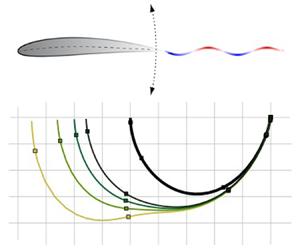Published online by Cambridge University Press: 24 February 2021

We extend unsteady thin aerofoil theory to aerofoils with generalised chordwise porosity distributions by embedding the material characteristics of the porous medium into the linearised boundary condition. Application of the Plemelj formulae to the resulting boundary value problem yields a singular Fredholm–Volterra integral equation which does not admit an analytical solution. We develop a numerical solution scheme by expanding the bound vorticity distribution in terms of appropriate basis functions. Asymptotic analysis at the leading and trailing edges reveals that the appropriate basis functions are weighted Jacobi polynomials whose parameters are related to the porosity distribution. The Jacobi polynomial basis enables the construction of a numerical scheme that is accurate and rapid, in contrast to the standard choice of Chebyshev basis functions that are shown to be unsuitable for porous aerofoils. Applications of the numerical solution scheme to discontinuous porosity profiles, quasi-static problems and the separation of circulatory and non-circulatory contributions are presented. Further asymptotic analysis of the singular Fredholm–Volterra integral equation corroborates the numerical scheme and elucidates the behaviour of the unsteady solution for small or large reduced frequency in the form of scaling laws. At low frequencies, the porous resistance dominates, whereas at high frequencies, an asymptotic inner region develops near the trailing edge and the effective mass of the porous medium dominates. Analogues to the classical Theodorsen and Sears functions are computed numerically, and Fourier transform inversion of these frequency-domain functions produces porous extensions to the Wagner and Küssner functions for transient aerofoil motions or gust encounters, respectively. Results from the present analysis and its underpinning numerical framework aim to enable the unsteady aerodynamic assessment of design strategies using porosity, with implications for unsteady gust rejection, noise-reducing aerofoil design and biologically inspired flight.